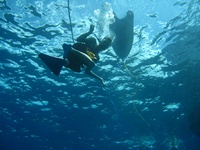
Snuba (a portmanteau of "snorkel" and "scuba") is a method of underwater swimming in which the swimmer uses the swimfins, diving mask, weights, and breathing apparatus commonly used in scuba diving, but the air tanks which are usually strapped to the back are instead laid horizontally in 5`-long rubber pontoon rafts that remain on the water`s surface. Snuba is typically used as a form of "introductory diving" (diving done in the presence of a professional, insured guide, and following a very short lesson, but not requiring a SCUBA certification). Snuba diving is a popular activity in tropical tourist locations such as Hawaii because of its relative ease and because one need not be SCUBA certified to participate. Its popularity as a first timer`s experience can be attributed to several factors. The professional diveguide is usually physically tied to the rafts, and the rafts are connected by airhose to the customers. This keeps the diveguide`s hands free, but still gives the customer the secure knowledge that he/she can`t become separated from the diveguide. The beginner/customer is physically connected to a canoe-like rubber raft with a handle-like around its perimeter, giving a feeling of safety, and the option to hold onto the raft while staying with the group. The weight of the gear carried by the beginner/customer is only slightly more than the weight of the weightbelt. Compare this to to full SCUBA gear which includes a buoyancy compensator, weights, cylinder and often more, and can weigh in excess of 60 pounds. Although the equipment is nearly weightless underwater, out of the water the weight becomes a significant factor for weaker individuals. On the negative side, in strong current, wave action or breeze, the combination of underwater hose and surface raft can pull quite hard on a diver. Snuba is therefore best used in areas where wind, waves and current are negligible. If the depth of a snuba dive is limited to 20 feet (6 metres), decompression sickness is not likely to be a problem. However, as the snuba diver is breathing compressed air, there is still a significant risk of injury or death due to air embolism which is a more severe hazard at shallow depths if a diver ascends as little as three feet without venting the expanding gas volume in the lungs. Due to the lack of training or experience, many first time snuba divers experience a period of panic and hyperventilation while trying to draw breath with their face in the water for the first time. The snuba divers are typically an afterthought to the dive boat if there are any scuba divers to attend to, so "training" is often little more than attaching the gear, helping them into the water, and telling them to relax and have fun. Snuba diving is not designed to compete with, or be an alternative to, scuba diving. Snuba diving is for non-divers and those who simply want to experience breathing and exploring underwater without the complication or training normally associated with diving. Snuba diving and scuba diving are never conducted in concert with each other.